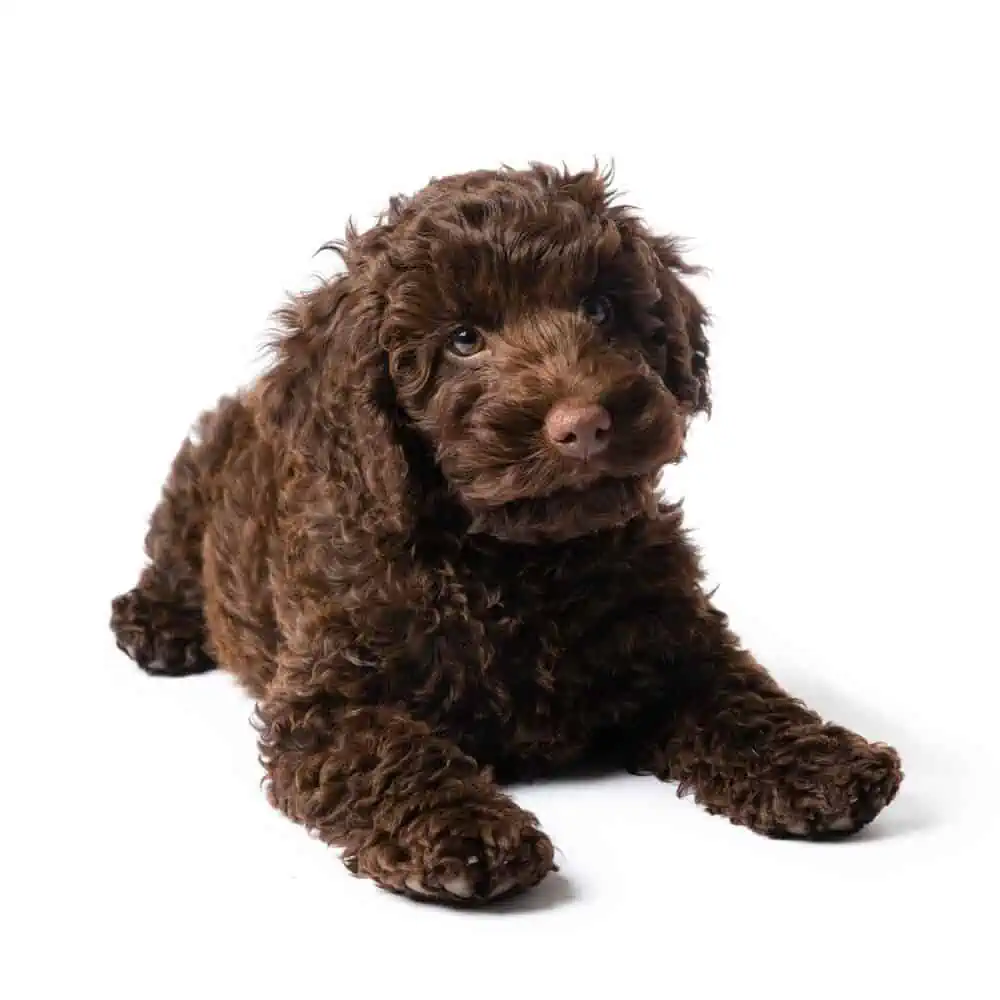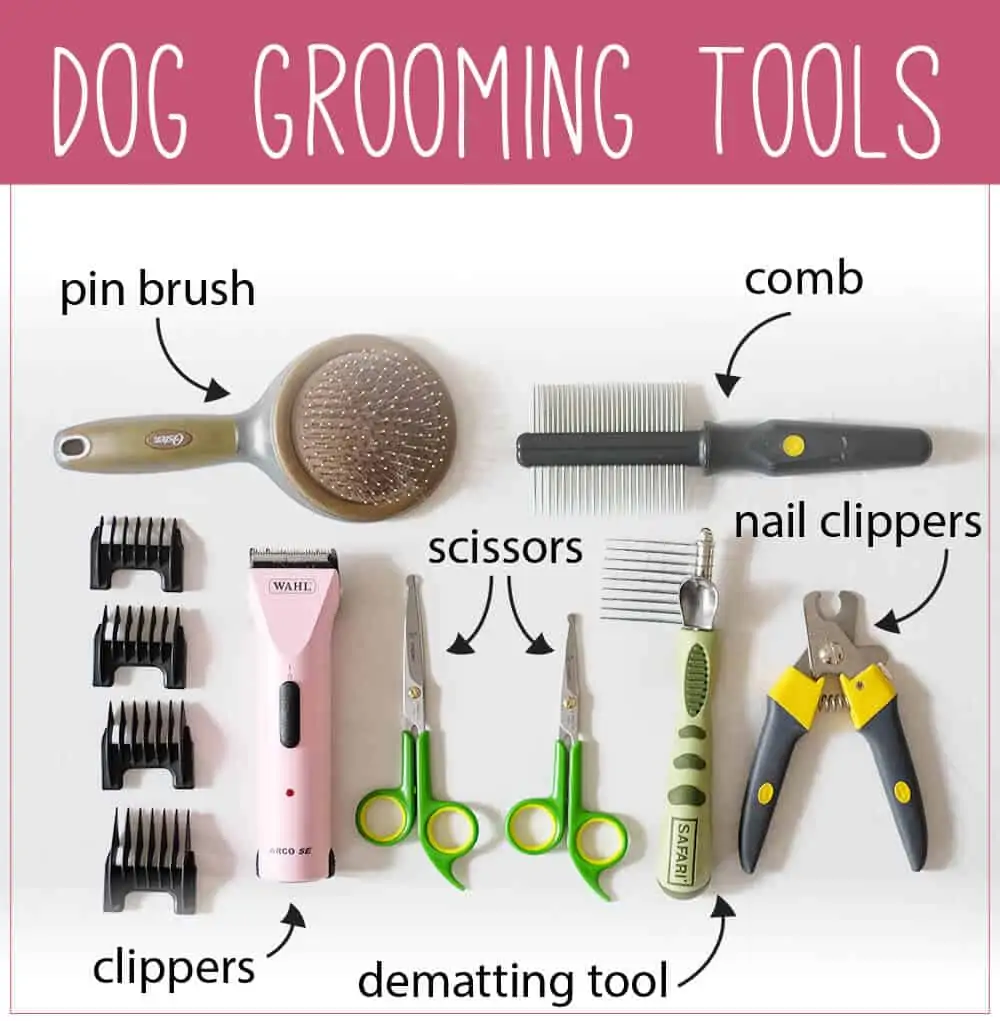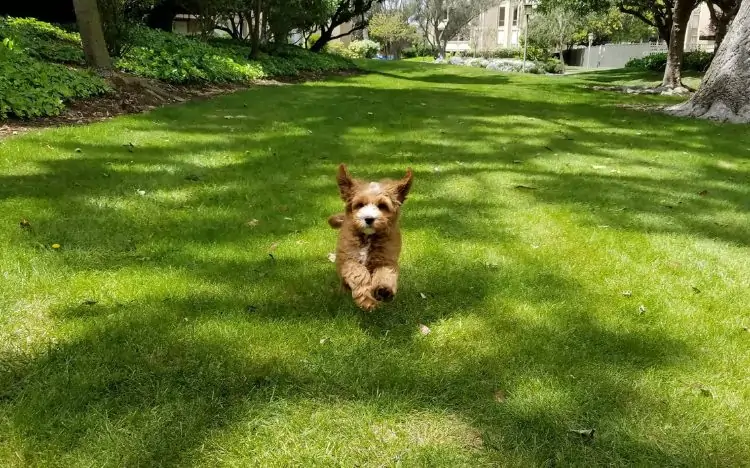Last Updated on
Like Standard Labradoodles, Mini Labradoodles are gaining popularity. Let’s learn about this Doodle-type dog so you can decide whether a Mini Labradoodle is the right dog for your family.
I’ll even tell you why I don’t think you should get a Mini Labradoodle.
Ready to uncover why? Let’s read on.
| Mini Labradoodle Breed Facts | |
| Height | 10 to 13 inches |
| Weight | 10 to 30 pounds |
| Temperament | Friendly, loyal, protective, intelligent, energetic |
What is a Mini Labradoodle?

A Mini Labradoodle is a cross between a Labrador Retriever and a Miniature or Toy Poodle.
Miniature Labradoodles are smaller versions of standard-sized Labradoodles, making them great for people searching for a small low-shedding dog.
Some people call the Mini Labradoodle a ‘designer dog’, which is a fancy way of saying they’re a mixed breed.
Temperament and personality of a Mini Labradoodle
The best way to understand the personality of a Miniature Labradoodle is to take a quick look at both parent breeds. So, before we dive into the temperament of the Mini Labradoodle, let’s learn about the Toy Poodle and Labrador Retriever.
Mini/Toy Poodle

Miniature Poodles were initially bred to be mushroom hunters and companion dogs.
They’re incredibly loyal, have excellent sniffing abilities, and have endless energy for playing.
Miniature Poodles come in two sizes: Mini and Toy. Toys are the smallest of the bunch, so if you’re looking for a very small Mini Labradoodle, see if you can find one with a Toy Poodle parent rather than a Miniature Poodle parent.
Labrador Retriever

Labs are high-energy dogs initially bred for hunting ducks in Newfoundland. They have water-resistant coats, which were helpful when swimming in the icy cold Newfoundland waters. Additionally, they have thick tails and webbed feet that help them swim effortlessly.
These dogs are full of energy and love to work—they’re eager to please, intelligent, and easy to train.
Mini Labradoodle
Now that we’ve gotten to know both parent breeds let’s look at what makes a Miniature Labradoodle so unique.
Energetic
Like both parent breeds—but more so the Lab—Mini Labradoodles are known to be energetic and lively.
They have a lot of energy and require daily exercise to keep them healthy and happy. Mini Labradoodles are particularly fond of outdoor activities like hiking, jogging, and especially swimming, and they make great companions for active individuals and families.
They also enjoy playing with toys and playing fetch and tug-of-war games.
Loyal
Mini Labradoodles are known for their loyalty and devotion to their owners.
They are affectionate dogs who thrive on human companionship and are always eager to be close to their family. Mini Labradoodles are social creatures, and they tend to get along well with other dogs and pets as long as they are properly socialized.
Intelligent
Also, since both the Labrador Retriever and the Miniature Poodle are intelligent, you can also expect the Mini Labradoodle to be highly-intelligent. Their intelligence makes them easy to train, especially for first-time dog owners.
Mini Labradoodles make excellent therapy dogs because of their intelligence and gentle nature.
Protective
Although Mini Labradoodles are friendly and sociable dogs, they also have a protective streak.
They are naturally alert and bark to alert their owners to potential danger.
However, they are not aggressive dogs and are unlikely to become territorial or overly protective when socialized properly.
Mini Labradoodles are an excellent choice for families who want a dog that will keep them safe without being overly aggressive.
Social
The Miniature Labradoodle is an outgoing and social dog who loves meeting new people and other animals. They thrive on human affection and can suffer from separation anxiety if not appropriately trained as a puppy.
As they require human companionship, Miniature Labradoodles are best suited for homes where someone will be around more often than not.
Eager to please
One of the most endearing traits of the Mini Labradoodle is their eagerness to please their owners. Other types of Doodle dogs, like Mini Sheepadoodles or Mini Bernedoodles, tend to be slightly stubborn, but not the Mini Labradoodle. Due to their natural desire to please their owners, they’re easy to train and will listen to commands.
They are quick to learn and respond well to positive reinforcement training techniques.
What does a Mini Labradoodle look like?

Height
Mini Labradoodles tend to be around 10 to 13 inches in height. Depending on their parent’s size, they can be a bit bigger or smaller.
If they’re bred with a Toy Poodle, they’ll likely be on the smaller side, and when bred with a Miniature Poodle, they will be a bit bigger.
Weight
Mini Labradoodles can weigh anywhere from 10 to 30 pounds. The best way to get an estimate for the weight of a full-grown dog is to speak to a breeder. They can tell you the size and weight of both parent dogs and estimate how big they think the Mini Labradoodle puppies will get.
Keep in mind that no breeder can fully guarantee a weight or size for the pups.
Colors
The most popular Mini Labradoodle coat colors are cream, chocolate, red, and golden.
But because Toy Poodles come in so many different colors and patterns, so can Mini Labradoodles. You might see colors and patterns like:
- Merle
- Parti
- Phantom
- Tuxedo
Some coat colors and patterns—like merle—command higher price tags, so if you come cross puppies with these coats, you can expect to pay a little more.
Coat type
Mini Labradoodles have coats that range from straight to curly, but they typically fall somewhere in between and have long wavy hair.
As the Miniature Labradoodle’s coat is low- to non-shedding, you’ll need to brush their coats to keep them from developing tangles and mats.
Fun fact: Mini Labradoodles have hair, not fur! There’s a slight difference between hair versus fur in dogs. You can read the linked guide if you want to know more.
Generations of Miniature Labradoodles
While searching for Mini Labradoodle puppies, you may come across terms like F1 Mini Labradoodle or F1B Mini Labradoodle.
If you don’t know what these terms mean, I’ll help you get up to speed:
- F1 is a Mini Labradoodle bred with a Mini/Toy Poodle and a Labrador Retriever.
- F1B is a Mini Labradoodle bred with a Mini/Toy Poodle and a Mini Labradoodle, making this type of Mini Labradoodle 75% Poodle. These are best for people who need a dog with a low-shedding coat.
- F2 is a Mini Labradoodle where two F1 Mini Labradoodles are bred together.
Lifespan of a Mini Labradoodle
Mini Labradoodles can live up to 15 years.
As always, the lifespan of your dog depends on how well they are taken care of. It’s also essential to buy from a reputable Labradoodle breeder who tests the parents for disease to eliminate any illness that may shorten your Mini Labradoodle’s lifespan.
Health issues and diseases that Mini Labradoodles are prone to
With good care and regular trips to the vet, you can avoid lots of health issues and diseases.
However, Labradors and Mini Poodles are prone to certain health issues that can affect a Mini Labradoodle as well, such as:
- Hip Dysplasia: This is a common condition where the hip joint does not develop properly, leading to discomfort and mobility issues.
- Progressive Retinal Atrophy (PRA): This is a genetic eye condition that leads to a gradual loss of vision and can ultimately result in blindness.
- Epilepsy: This is a neurological disorder that can cause seizures and other related issues.
- Patellar Luxation: This is a condition in which the kneecap slips out of its normal position, causing pain and mobility issues.
- Hypothyroidism: This condition is when the thyroid gland does not produce enough hormones. It can cause weight gain, lethargy, and skin problems.
- Ear Infections: Both Labrador Retrievers and Toy Poodles have floppy ears, which can trap moisture and dirt, making them prone to ear infections. Ask your vet for the best ear-cleaning practices. Some vets may recommend plucking the hair in the ears while others may suggest weekly ear cleanings at home with a cleaning solution. Our vet recommended the latter for us, which is what we do to keep our dog’s floppy ears infection-free.
A good breeder will screen the parent dogs for various issues to ensure the puppies have the best chance at a healthy life.
Where to find Mini Labradoodle puppies
Mini Labradoodles are a popular dog breed and are relatively easy to find. Here a couple of different options.
Reputable breeders
The easiest place to find a Mini Labradoodle puppy is through a reputable breeder. I put together a directory of Labradoodle breeders to help you start your search, but keep in mind that the list I’ve put together is only a directory—you still need to do your own research.
Here are a few things to consider when vetting potential breeders:
- Does the breeder have contracts? Breeders will always make buyers sign a contract. It’s a red flag if your breeder doesn’t.
- Does it seem like the breeder is breeding for profit or because they love the breed? Breeders who have many litters per year might be in business for the wrong reasons, aka purely for the money. A reputable breeder wants to better the breed, not make a quick buck.
- Does the breeder let you visit the facilities and meet the parent dogs? Most breeders let you tour their facilities so you can ensure the puppies are being brought up in a good environment.
- Does the breeder health test the parents? All breeders should perform health tests on the parents to ensure they are breeding healthy puppies.
Rescue agencies
Plenty of rescues have Poodle mix dogs! In fact, I adopted my Standard Labradoodle from a local rescue agency.
While you might not find a puppy, there are lots of adult dogs to adopt. Search through my list of Doodle dog rescues to see which types of Poodle-mix dogs are available for adoption right now.
You can—and should—contact Labradoodle breeders in your area to see if they take back surrendered puppies. Oftentimes, breeders will take back dogs when their owners can no longer care for them. The breeder will then adopt the dog out to a suitable family.
Cost of Mini Labradoodle puppies
The price of a Mini Labradoodle puppy ranges from $1,500 to $4,500 depending where you you. Typically, miniature-type dog breeds are more expensive than the standard variety.
If you come across a price that’s too good to be true, it probably is, and can be an indication of a backyard breeder.
Training a Mini Labradoodle
Miniature Labradoodles are quick learners and love training sessions. They are great for first-time dog owners as they pick up commands quickly and are eager to please their owners.
As with any dog, early socialization and training are essential for Miniature Labradoodles to develop good behavior and manners.
Consider bringing your Mini Labradoodle to puppy socialization classes and teaching them basic commands like sit, stay, leave it, recall, and leash training.
Related: Labradoodles versus Goldendoodles
Grooming a Mini Labradoodle

Mini Labradoodles have demanding coats and require constant grooming at home and at the groomers.
I put together a guide on grooming Doodle dogs at home, and I highly recommend checking it out to see what it all entails.
In most cases, you can expect to brush and comb your Mini Labradoodle for 15 minutes every other day to keep their coats tangle and mat-free. Mats can be very painful and can even cause skin lesions and infections, so it’s crucial to take time each week to brush and comb your pup.
You should also visit the groomer every six to eight weeks for full grooms.
On top of taking care of their coats, you’ll need to trim their nails, clean their teeth, and clean their ears.
Reasons not to get a Miniature Labradoodle
Many people rush out to get a Miniature Labradoodle because they seem like great dogs—and they are.
But unfortunately, Mini Labradoodles end up in shelters because people didn’t do enough research prior. So, to play Devil’s advocate, I’m going to list a few reasons why you shouldn’t get a Mini Labradoodle:
- They’re expensive. And not just their initial cost. I mean the cost of frequent trips to the groomers. It’s a good idea to call local groomers in your area to see how much you can expect to pay for a groom every six to eight week. On top of that, you should consider getting their teeth cleaned once a year. This can range from $200 to $1,000 depending on where you live. Toy Poodles have small mouths and as such, they need regular teeth cleanings. Same with Miniature Labradoodles.
- They demand lots of exercise. If you’re looking for a quiet lap dog, the Mini Labradoodle is not a good match for you.
- They have high maintenance coats. Brushing and combing them is non-negotiable unless you want to keep them shaved down and visit the groomers more frequently.
If the above points aren’t deal breakers to you, then a Mini Labradoodle could be a perfect addition to your family!
Should you get a Mini Labradoodle?
Mini Labradoodles are easy-going, playful, and intelligent family dogs. They’re loyal to their owners and get along with children and other pets, making them easy to add to big families!
If you’re an active person who wants a small pup to join you on adventures, a Mini Labradoodle could be the perfect companion for you.
Do you have or know someone with a Mini Labradoodle? Let us know what its like in the comments below!
FAQs
A Miniature Labradoodle costs anywhere from $1,500 to $4,500.
This article may include affiliate links. www.travellingwithadog.com is a participant of Amazon.com Services LLC Associates Program. As an Amazon Associate, I earn a commission from qualifying purchase. www.travellingwithadog.com participates in other affiliate programs, and recieves commissions when purchases are made through the links. The cost is not inflated to account for the commission earned.
Veterinary Disclaimer: travellingwithadog.com is not a substitute for veterinary advice and does not intend to provide any type of veterinary advice for your animals. Please consult your vet for any questions you have regarding your pets health.

About the Author:
Dana owns a Sheepadoodle and a rescue merle Labradoodle. Her first dog growing up was a white Toy Poodle and she’s loved dogs ever since. She has years of experience fostering dogs and has helped find homes for a variety of different breeds, both large and small! After seeing so many dogs end up unwanted and in shelters, she began blogging about different dog breeds (specifically Doodle dogs, since that’s what she knows best) to help people make informed choices when adding a new member to their family.
When Dana’s not brushing her Doodles’ hair (it takes a lot of time for two!) you can find her playing nose work games and fetch with her two amazing pups.
Learn more about her here.

